The Independent Citizens Redistricting Commission convenes once a decade to perform one of the most essential tasks in city government.
The cynical view of city politics is that it’s all about money and powerful interests.
Yet those forces aren’t readily apparent in the ongoing work of the Independent Citizens Redistricting Commission (ICRC), a group of 14 unpaid Austinites who were selected partially at random from a large pool of vetted applicants.
Under the 10-1 geographic council system created through a voter-approved change to the City Charter in 2012, the city has to redraw its boundaries every decade, to account for population changes. It’s similar to what happens at the state level when congressional and state legislative districts are redrawn. But in Austin the task falls not to elected politicians but to a citizens commission.
Each member of the volunteer commission will dedicate many hours over the next few months to redraw the city’s 10 council districts. It’s a job that will involve poring over census data, examining detailed demographic analysis, and weighing citizen input from across the city.
A handful of hired professionals will assist in the task—a mapping consultant, lawyer, and administrative manager—but the actual decisions will be made by the commissioners.
The group includes Austinites of diverse backgrounds, including an accountant, business analyst, small business owner, retiree, church pastor, and tech executive.
Several have specialized skills that may be relevant to the commission’s task, including a University of Texas at Austin geography student, a UT politics professor, and a graduate student at the LBJ School of Public Affairs.
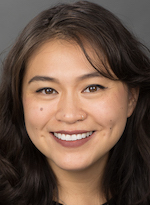
Chair Christina Puentes, the graduate student, told the Bulldog that she was motivated to join the commission out of an interest in “increasing democratic participation and representation, and for me in particular with the lens of representation for historically oppressed people.”
“We’re still seeing a lot of manipulation at the state level with gerrymandering practices…I may not be able to change that gerrymandering at that state level—the rigged drawing of districts that benefit politicians over people—but I can do everything in my power to draw fair lines for the city.”

Similarly, Vice Chair Luis Gonzalez said he applied for a spot on the commission after learning about its importance at ATXelerator, a nine-week civics program similar to a startup accelerator, which encourages participants to get involved in local government. “Shortly after the end of the program, I noticed the application announcement for the Independent Citizens Redistricting Commission. I was tired of complaining about political injustice and inequities. I viewed this commission as one way to actually do something to right the wrongs,” he wrote in an email.
‘Independent with a capital I’
Unlike members of other city boards and commissions, the ICRC commissioners weren’t appointed by the council. Instead they applied to the city auditor’s office, which then oversaw a rather elaborate selection process that was carried out over a period of about nine months, involving screening for minimum requirements plus two random drawings.
The first step was for city auditor Corrie Stokes to solicit applications for a three-member Applicant Review Panel consisting of licensed auditors with at least five years experience. Out of 44 applicants, 16 met the minimum requirements, and three were then chosen randomly in October 2020: James Christianson, William Cooper, and Abigael McClean. This panel then had the task of narrowing down the applications for the ICRC itself.
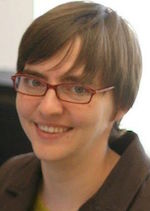
Out of more than 300 applications received, about 10 percent were weeded out because they didn’t meet minimum requirements, such as having a conflict of interest, not being a registered voter, or not having voted in at least three of the last five general elections.
That left a qualified applicant pool of 270. From there the auditors evaluated the candidates on the basis of “relevant analytical skills, ability to be impartial, residency in various parts of the city, and appreciation for the City of Austin’s diverse demographics and geography,” in accordance with the city charter. They selected the 60 applicants they thought were most qualified.
After that, city council members had a five-day window to tweak the list, albeit only slightly. The charter gives each council member the right to strike one candidate from the pool of 60. But none of the council members did so, according to Matthew Dugan, a city staffer from the Housing and Planning Department assigned as a liaison to the commission.
Finally, eight people from the list of 60 were selected at random to become the first commissioners. They in turn selected the remaining six members out of the same applicant pool. The result is a 14-member body that began meeting in June (May for those selected first) and will continue at least through November.
“We’re independent with a capital ‘I’,” says Puentes. “At a time when politicians often elicit mistrust, citizen redistricting can provide an alternative to politics as usual.”
In an interview, she stressed that “there is absolutely no connection between anyone on this redistricting commission and anyone with the city. We’re vetted for that, in fact that’s just part of the application process that you or your partner, your spouse, cannot have any connections to the council, the mayor, or even have worked for the city in the last five years.”
Puentes noted that the charter also prohibits communication between the commission and council members or the mayor outside of a public meeting.
Being independent of the sitting council doesn’t mean, of course, that commissioners don’t have their own political views and experiences. Puentes, for example, worked recently on the successful Austin ISD school board campaign of Kevin Foster, a UT professor. Sterling Lands, a senior pastor of Greater Calvary Bible Church, founded the Eastside Social Action Coalition in 2000, which pressured AISD to improve academic performance among minority students.
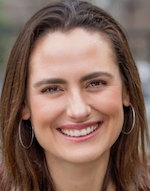
Erin Dempsey, a former commercial real estate attorney and business owner, is currently enrolled in the LBJ Women’s Campaign School, which trains women to run for office or manage campaigns. (After serving on the ICRC, she’ll be ineligible for city office for the next decade).
Also of note, three commissioners—Joshua Blank, Dempsey, and Gonzalez—are 2020 alumni of ATXelerator, which has been called a “boot camp for people who want to run for public office.” They were in the same cohort as Vanessa Fuentes, who won a council seat in 2020.
Gonzalez told the Bulldog that he would be interested in one day running for council: “While my spot on the commission now prevents me from running for city office for 10 years, I hope it gives me the time to effectively craft my message and priorities.”
Other commissioners had no apparent political or civic involvement prior to joining the ICRC, according to their biographies on the ICRC website.
Overcoming public apathy
The group has taken up its task with gusto. Most city boards and commissions meet quarterly or monthly, but the ICRC is meeting weekly plus holding two public forums every week. “Each commissioner is also involved in at least one working group or subcommittee to help move us along, because there are so many moving parts,” Puentes said.
“There’s a lot of work happening behind the scenes Monday through Sunday, so we have divided the work into a few buckets. We have a communications working group, a public forums working group, finance subcommittee, and then a final report subcommittee that will produce a report of all the work that we’ve done…that will be published hopefully by the end of this year.”
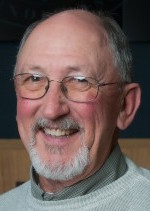
Stefan Haag, a former ICRC commissioner who served in 2013, told the Bulldog that he’s been generally impressed with the performance of the commission so far. Initially he had some concerns in May over hiccups during the selection process, but those have been addressed, he said.
On the other hand, public engagement with the ICRC has been noticeably lacking. There haven’t been more than a dozen people at any of the meetings, Puentes said. In August the commission switched to virtual meetings owing to an uptick in Covid-19 cases. At the first virtual forum August 3, a handful of residents tuned in but only one spoke.
That’s a steep drop-off compared to 2013, when similar meetings were held. “We would get 50 to 60 people at every event,” said Haag, the former commissioner.
“Engagement was very good. And the way we conducted the meetings was basically a person had a chance to talk and present their ideas about what they wanted in a district and what the neighborhoods were, things like that.”
Haag thinks that the novelty of the single-member-district system has worn off, which accounts in part for the change. But Covid-19 and a drop in civic engagement in general might also have something to do with it.
The low turnout isn’t for lack of trying on the part of the commission, according to Puentes. “We have tried our best to get people engaged and it has been difficult. Our communications team sends out press releases to the media and we have a community list that is in the hundreds. We’ve been featured in various publications and on local TV in both English and Spanish. We have a website. People can reach us also at SpeakUp, Austin. We’re on Facebook, Instagram and Twitter, and the city also posts about us on their website, which encourages city council members to share about us in their newsletters.”
While citizen input has been muted so far, Puentes expects things to heat up once preliminary maps are actually drawn and presented to the public: “I think we’ll hear a lot more from folks once Austinites have seen those preliminary maps.”
Standards for drawing the maps
Over the past decade Austin’s population grew by 171,465, or 21 percent, according to 2020 census numbers released Thursday. Uneven growth across the city means that some districts will have to increase in size, while others must be reduced.
Based on the city’s total population of 961,855, the ideal council district should have a population of about 96,000. With that target in mind, the ICRC can now set to work adjusting district boundaries. According to the city charter, the commission doesn’t have to draw districts that are exactly equal in population, but it should aim for districts that are “reasonably equal.”
That’s the top criterion that the commission must weigh as it redraws the council district map, but it’s not the only one. Next in order of priority is that the map complies with the 1965 Voting Rights Act and other state and federal laws. That means not drawing districts in ways that deliberately dilute the voting strength of racial minorities.
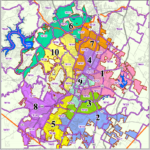
Other requirements under the charter are intended to avoid the creation of gerrymandered districts that sprawl funkily across the map, as Congressional districts sometimes do. “To the extent practicable, district boundaries shall be drawn to encourage geographical compactness such that nearby areas of population are not bypassed for more distant populations,” the charter says. “The geographic integrity of any local neighborhood or local community of interest shall be respected in a manner that minimizes their division to the extent possible without violating the requirements of any of the preceding subsections.”
Lower-level priorities for the commission to consider include aligning district boundaries with existing election precincts, and considering natural barriers like rivers and valleys. Where these criteria conflict with each other, the charter lays out an order of priority.
Finally, there’s one big thing that the commission is not supposed to consider: “the place of residence of any incumbent or potential political candidate.”
Things to watch
Looking ahead, there are several key issues to watch as the commission carries out its task:
Political fallout—Redistricting could have important consequences for council members who might wish to run for reelection. For example, a council member with strong support in a certain area might no longer represent that area. Two incumbents could also end up being redistricted into the same district. That happened in the original districting process in 2013, when the only two incumbent council members eligible to run for election both wound up in District 9. Kathie Tovo defeated Chris Riley to win that seat. For such reasons, the process is likely to be watched closely by political strategists, council members, and potential candidates for office.
Structural independence—This is only the second time that the redistricting process has occurred, so it’s important to watch whether the commission is able to function truly independently. The members of the commission may not be beholden to particular council members, but are there any points of interference or influence? What kind of precedents and practices are established that might be continued when future commissions meet?
Neighborhood input—Because the commission is tasked with trying to preserve the “geographic integrity of any local neighborhood or local community of interest,” it’s important for commissioners to try to understand how Austinites self-define into neighborhoods and communities. That’s why the commission is holding so many public forums, and why public input will be sought again after preliminary maps are released.
November deadline—The charter gives the commission a November 1 deadline for adopting a final map. That’s a tight timeframe because of a delay in the release of census data, which didn’t come out until August 12th. Under the charter, if the commission doesn’t meet the November deadline the city attorney is charged with petitioning a state court for an order prescribing an interim map, until the ICRC adopts its own. Puentes told the Bulldog, “We are all very sure that we can meet that November 1st deadline even though it is tight.”
She added, however, that “there’s a chance we’ll go back a few weeks later and clean up the maps,” to adjust for changes that Travis County might make to election precinct boundaries later in November. “We want to minimize splitting election precincts as much as possible.”
Opportunity districts—Finally, a key feature of the redistricting process in 2013 was the creation of opportunity districts, which contain a majority or plurality of Black or Hispanic residents. In fact, the opportunity districts were the first ones drawn that year, according to Haag, the former commissioner. District 1 was drawn as an African American opportunity district, and Districts 2, 3, and 4 were drawn as Hispanic opportunity districts.

Opportunity districts are a construct under federal case law and the Voting Rights Act of 1965, designed to prevent the deliberate dilution of minorities’ voting strength either by dividing them among many districts (“cracking”), or by sticking them all into a single district (“packing”). Attorney Roger Borgelt says that districts drawn on the basis of race are legal if they “further a compelling state interest,” such as “remedying past or present discrimination.”
“So that’s why we’re focused on drawing districts that protect the rights of Hispanics and African Americans,” Borgelt told commissioners in a briefing July 7.
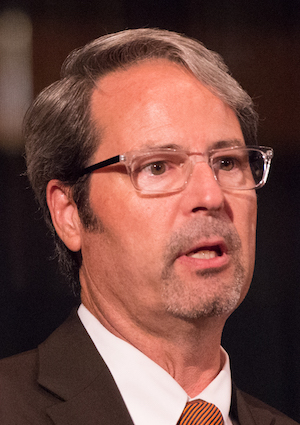
Borgelt was speaking on behalf of the NAACP/Hispanic Coalition, an informal group made up of members of the former Austinites for Geographic Representation (AGC), which spearheaded the creation of the 10-1 council system. AGC got the measure on the ballot in 2012 and built a coalition of some 30 organizations to back its victory over the last-minute alternative proposition put on the ballot by the City Council. Members of the group involved in this year’s redistricting include former State Senator Gonzalo Barrientos, NAACP Austin President Nelson Linder, former Council Member Ora Houston, and longtime Democratic political strategist Peck Young.
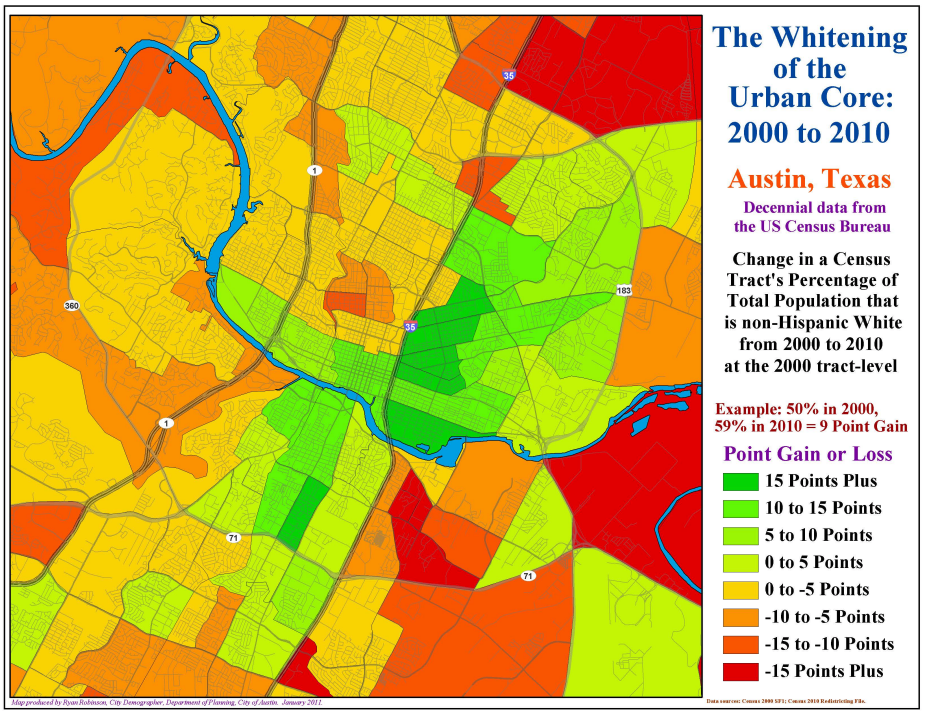
Coalition members are urging the commission to again draw four opportunity districts. But the Black population of Austin has grown less concentrated and more dispersed throughout the city in recent decades, according to Ryan Robinson, a former city demographer.
In a presentation to the commission, he showed a slide titled, “The Whitening of the Urban Core: 2000 to 2010.” It featured a color-coded map showing rapid growth of the White population in East Austin in proportion to the overall population. That’s a trend driven both by Whites arriving and by Blacks leaving, and is linked to socioeconomic factors referred to as “gentrification.”
Robinson said, “This is what I expect you will see again when we get data from 2020, we’ll see something very similar that happened from 2010 to 2020.”
If census data confirms that trend, it could complicate the process of creating opportunity districts. Robinson said, “What is the 2020 map going to look like? I think it’s going to be even more spatially dispersed, which is going to make your task of creating this African American opportunity district really, really tough.”
 Trust indicators: Bulldog reporter Daniel Van Oudenaren is a journalist with 12 years experience in local, state, and international reporting.
Trust indicators: Bulldog reporter Daniel Van Oudenaren is a journalist with 12 years experience in local, state, and international reporting.
Links to related documents
Article II, Section 3 of the Austin City Charter (Redistricting)
Links to related Bulldog coverage:
If Harper-Madison loses District 1 Runoff, Austin Loses Its Only Black Council Seat, December 5, 2018
Light Turnout for City Auditor’s Meetings, July 29, 2013
Redistricting Veteran Shares His Wisdom, May 2, 2013
Bumpy Road to Implementing 10-1, January 17, 2013
Massive Interest in Redistricting, December 6, 2012
Feisty Debate Over How to Elect Council, October 4, 2012
Redistricting Need Not Be a Quintessentially Political Process, September 23, 2012
Barrientos Lampoons Prop 4 With a Fable, September 14, 2012
Petition Drive Completed for 10-1 Council Districts, July 17, 2012
Austinites for Geographic Representation to Submit Petitions, July 4, 2012
Council Puts 10-1 Plan on November Ballot, June 29, 2012
At-Large Elections Favor Anglo Choices, August 4, 2011








Interesting story that seems well researched and presented. I would like to see how the desire for “opportunity districts” fits with the goal of anti-gerryandering. I expect conflict here. Looking forward to continued coverage as this effort progresses.
This is a fine article, as usual, Bulldog. I appreciate Daniel Van Oudenaren’s thorough writing.
I have this to add. I believe the reason 10-1 was passed was due to the tension between the measure for 10-1 being placed on the ballot through a citizens petition drive versus the Council’s plan, which maintained some at-large seats AND allowed them to draw the lines — no citizen’s commission was included. The petition was on the street — 27K signatures were gathered on paper. That meant our coalition had to talk to at least 50K to get the signatures.
This really shouldn’t be overlooked. I realize the Bulldog covered this extensively back in 2012, but it’s been a long time. AND, it’s essential to the story because Austin has the only citizen’s commission in Texas to draw the lines because, I believe, we used the petition option.
That petitioning is only available for municipal elections in the state of Texas, makes plain to me why we were never get a commission to draw all the lines in Texas — that is unless and until there is a independent electoral outside both parties.
I also have to express my disappointment in nary a mention of my efforts through the independent ChangeAustin.org — now defunct. It was one thing to be written out of history by Judy Maggio, who made this effort about a fight between two political consultants. One of them, Peck Young, I consider to be a KEY reason for passage of 10-1. But don’t write the independents out of history.
With respect, Linda Curtis, Board Member, League of Independent Voters of Texas